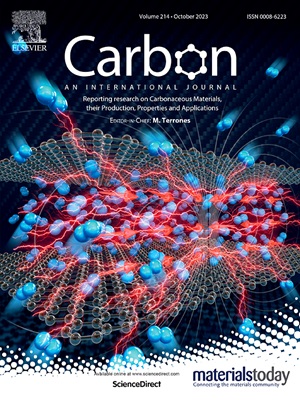高取向碳纤维复合材料各向异性热物理性能的研究:从一维到三维
IF 10.5
2区 材料科学
Q1 CHEMISTRY, PHYSICAL
引用次数: 0
摘要
高取向碳纤维复合材料具有三维各向异性热物理特性,使其成为热管理应用的候选材料。本研究系统地研究了高取向碳纤维/环氧树脂(CF/ER)复合材料及其组分的热性能。采用t型探针法测量节距CF,结合2ω法和激光点周期性加热法对E51-ER薄膜及其复合材料进行表征。通过有限元模拟分析了纤维局部弯曲对复合材料传热的影响。结果表明,复合材料沿纤维取向具有较高的导热性,各向异性比约为294。在不同温度下,沿纤维取向的导热系数低于平行模型的预测值,而其他两个方向的导热系数明显高于串联模型的预测值。仿真结果表明,特定节距CF的弯曲可能是造成这种差异的关键因素。本文章由计算机程序翻译,如有差异,请以英文原文为准。
Investigation of anisotropic thermophysical properties of highly oriented carbon fiber composites: From one to three dimensions
Highly oriented carbon fiber composites exhibit three-dimensional anisotropic thermophysical properties, making them candidates for thermal management applications. In this study, the thermal properties of highly oriented carbon fiber/epoxy resin (CF/ER) composites and their components were systematically investigated. The T-type probe method was employed to measure the pitch CF, while the 2ω method and the laser-spot-periodic-heating method were combined to characterize the E51-ER film and the composites. The impact of local fiber bending on heat transfer in the composites was also analyzed through finite element simulations. The results show that these composites exhibit high thermal conductivity along the fiber orientation with an anisotropy ratio of about 294. At different temperatures, the thermal conductivity along the fiber orientation is lower than the value predicted by the parallel model, while the conductivity in the other two directions is significantly higher than that predicted by the series model. Simulation results suggest that the bending of certain pitch CF can be a key factor contributing to this discrepancy.
求助全文
通过发布文献求助,成功后即可免费获取论文全文。
去求助
来源期刊

Carbon
工程技术-材料科学:综合
CiteScore
20.80
自引率
7.30%
发文量
0
审稿时长
23 days
期刊介绍:
The journal Carbon is an international multidisciplinary forum for communicating scientific advances in the field of carbon materials. It reports new findings related to the formation, structure, properties, behaviors, and technological applications of carbons. Carbons are a broad class of ordered or disordered solid phases composed primarily of elemental carbon, including but not limited to carbon black, carbon fibers and filaments, carbon nanotubes, diamond and diamond-like carbon, fullerenes, glassy carbon, graphite, graphene, graphene-oxide, porous carbons, pyrolytic carbon, and other sp2 and non-sp2 hybridized carbon systems. Carbon is the companion title to the open access journal Carbon Trends. Relevant application areas for carbon materials include biology and medicine, catalysis, electronic, optoelectronic, spintronic, high-frequency, and photonic devices, energy storage and conversion systems, environmental applications and water treatment, smart materials and systems, and structural and thermal applications.
 求助内容:
求助内容: 应助结果提醒方式:
应助结果提醒方式:


